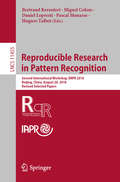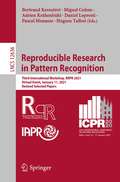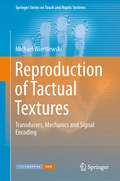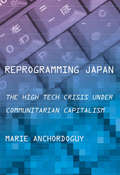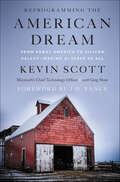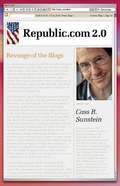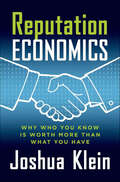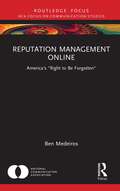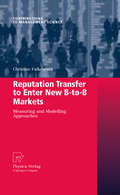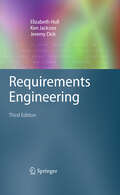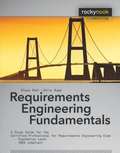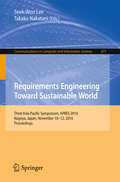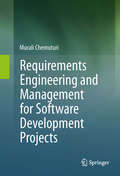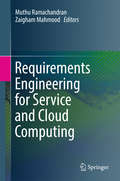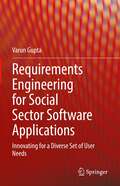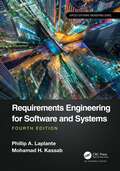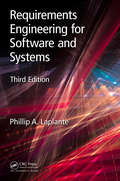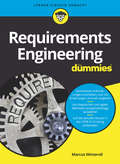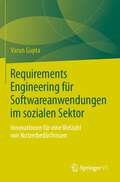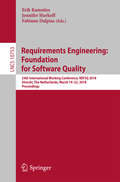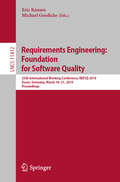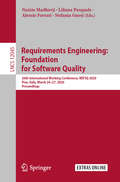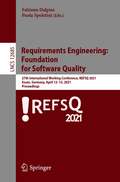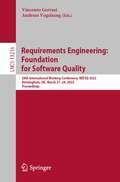- Table View
- List View
Reproducible Research in Pattern Recognition: Second International Workshop, RRPR 2018, Beijing, China, August 20, 2018, Revised Selected Papers (Lecture Notes in Computer Science #11455)
by Hugues Talbot Bertrand Kerautret Miguel Colom Pascal Monasse Daniel LoprestiThis book constitutes the thoroughly refereed post-workshop proceedings of the Second International Workshop on Reproducible Research in Pattern Recognition, RRPR 2018, in Beijing, China in August 2018.The 8 revised full papers, presented together 6 short papers, were carefully reviewed and selected from 14 submissions. This year the workshop did focus on Digital Geometry and Mathematical Morphology. The first track 1 on RR Framework was dedicated to the general topics of Reproducible Research in Computer Sciencewith a potential link to Image Processing and Pattern Recognition. In the second track 2 the authors described their works in terms of Reproducible Research.
Reproducible Research in Pattern Recognition: Third International Workshop, RRPR 2021, Virtual Event, January 11, 2021, Revised Selected Papers (Lecture Notes in Computer Science #12636)
by Hugues Talbot Bertrand Kerautret Miguel Colom Pascal Monasse Daniel Lopresti Adrien KrähenbühlThis book constitutes the thoroughly refereed post-workshop proceedings of the Third International Workshop on Reproducible Research in Pattern Recognition, RRPR 2021, held as a virtual event, in January 2021. The 8 revised full papers, presented together with 6 short papers, were carefully reviewed and selected from 18 submissions. The papers were organized into three main categories. The first contributions focused on reproducible research frameworks. The second category focused on reproducible research results and the last category included ICPR companion papers describing implementation and details that are an absolute requirement for reproducibility.
Reproduction of Tactual Textures
by Michaël WiertlewskiTexture accounts for an important part of the realism of simulated experiences, and it is most certainly true during tactile interaction. We usually experience roughness by running our fingers onto the explored surface. The perception of this fine texture is mediated by the vibrations generated by the encounters of the skin and the asperities of the surfaces. Reproduction of Tactual Textures presents factors that contribute to the mechanics of the interaction between a bare finger and a surface with a view to their artificial reproduction. It discusses the recording and reproduction of tactual textures, and analyses a case study of the development of a device able to record the vibratory signal from a fingertip sliding over a textured surface. The same device is then used in a reverse way to render those previously measured signals to the user's fingertip. These developments open new questions about the biomechanical properties of the skin and their relation to perception. The second half of Reproduction of Tactual Textures focuses on the implication of the dynamic parameters of the skin onto rendering performance, and it concludes with a study on the important features that are present in the vibratory signal and their relation to texture perception. This state-of-the-art volume highlights the importance of the mechanics and biomechanics during the haptic exploration of surfaces and their possible contribution to perception. Collectively, the findings reported are pertinent to many applications, including robotic perception and the design of effective virtual reality systems.
Reprogramming Japan: The High Tech Crisis under Communitarian Capitalism
by Marie AnchordoguyHow have state policies influenced the development of Japan's telecommunications, computer hardware, computer software, and semiconductor industries and their stagnation since the 1990s? Marie Anchordoguy's book examines how the performance of these industries and the economy as a whole are affected by the socially embedded nature of Japan's capitalist system, which she calls "communitarian capitalism." Reprogramming Japan shows how the institutions and policies that emerged during and after World War II to maintain communitarian norms, such as the lifetime employment system, seniority-based wages, enterprise unions, a centralized credit-based financial system, industrial groups, the main bank corporate governance system, and industrial policies, helped promote high tech industries. When conditions shifted in the 1980s and 1990s, these institutions and policies did not suit the new environment, in which technological change was rapid and unpredictable and foreign products could no longer be legally reverse-engineered. Despite economic stagnation, leaders were slow to change because of deep social commitments. Once the crisis became acute, the bureaucracy and corporate leaders started to contest and modify key institutions and practices. Rather than change at different times according to their specific economic interests, Japanese firms and the state have made similar slow, incremental changes.
Reprogramming the American Dream: From Rural America to Silicon Valley—Making AI Serve Us All
by Kevin Scott Greg Shaw** #1 Wall Street Journal Bestseller **In this essential book written by a rural native and Silicon Valley veteran, Microsoft’s Chief technology officer tackles one of the most critical issues facing society today: the future of artificial intelligence and how it can be realistically used to promote growth, even in a shifting employment landscape.There are two prevailing stories about AI: for heartland low- and middle-skill workers, a dystopian tale of steadily increasing job destruction; for urban knowledge workers and the professional class, a utopian tale of enhanced productivity and convenience. But there is a third way to look at this technology that will revolutionize the workplace and ultimately the world. Kevin Scott argues that AI has the potential to create abundance and opportunity for everyone and help solve some of our most vexing problems.As the chief technology officer at Microsoft, he is deeply involved in the development of AI applications, yet mindful of their potential impact on workers—knowledge he gained firsthand growing up in rural Virginia. Yes, the AI Revolution will radically disrupt economics and employment for everyone for generations to come. But what if leaders prioritized the programming of both future technology and public policy to work together to find solutions ahead of the coming AI epoch? Like public health, the space program, climate change and public education, we need international understanding and collaboration on the future of AI and work. For Scott, the crucial question facing all of us is this: How do we work to ensure that the continued development of AI allows us to keep the American Dream alive?In this thoughtful, informed guide, he offers a clear roadmap to find the answer.
Republic of Outsiders: The Power of Amateurs, Dreamers, and Rebels
by Alissa Quart&“Vivid portraits&” of individuals and subcultures by a writer who &“unmasks the assumptions we make about what counts as normal&” (The New York Times). They are outsiders who seek to redefine fields from mental health to diplomacy to music. They push boundaries and transform ideas. They include filmmakers crowdsourcing their work, transgender and autistic activists, and Occupy Wall Street&’s &“alternative bankers.&” These people create and package themselves in a practice cultural critic Alissa Quart dubs &“identity innovation.&” In this &“fascinating&” book, Quart introduces us to individuals who have created new structures to keep themselves sane, fulfilled, and, on occasion, paid. This deeply reported book shows how these groups now gather, organize, and create new communities and economies. Without a middleman, freed of established media, and highly mobile, unusual ideas and cultures are able to spread more quickly and find audiences and allies. Republic of Outsiders is a critical examination of those for whom being rebellious, marginal, or amateur is a source of strength (Barbara Ehrenreich). &“Even if you don&’t consider yourself an outsider or a rebel, Quart&’s book has several lessons for creative work, particularly when it comes to making art outside a heavily commercial system.&” —Fast Company &“One of the smartest cultural interpreters of her generation. In Republic of Outsiders, she mixes sharp-eyed analysis with an empathetic heart. The result is a great read, and a brand-new lens through which to view outsiders, insiders—and ourselves.&” —Susan Cain, author of Quiet: The Power of Introverts in a World That Can&’t Stop Talking
Republic.com 2.0
by Cass R. SunsteinWhat happens to democracy and free speech if people use the Internet to listen and speak only to the like-minded? What is the benefit of the Internet's unlimited choices if citizens narrowly filter the information they receive? Cass Sunstein first asked these questions in 2001'sRepublic. com. Now, inRepublic. com 2. 0, Sunstein thoroughly rethinks the critical relationship between democracy and the Internet in a world where partisan Weblogs have emerged as a significant political force. Republic. com 2. 0highlights new research on how people are using the Internet, especially the blogosphere. Sunstein warns against "information cocoons" and "echo chambers," wherein people avoid the news and opinions that they don't want to hear. He also demonstrates the need to regulate the innumerable choices made possible by technology. His proposed remedies and reforms emphasize what consumers and producers can do to help avoid the perils, and realize the promise, of the Internet.
Reputation Economics: Why Who You Know Is Worth More Than What You Have
by Joshua KleinAs the internet has increasingly become more social, the value of individual reputations has risen, and a new currency based on reputation has been created. This means that not only are companies tracking what an individual is tweeting and what sites they spend the most time on, but they're using this knowledge to predict the consumer's future behavior. And a world in which Target knows that a woman is pregnant before she does, or where a person gets a job (or loses one) based on his high school hijinx is a scary one indeed. Joshua Klein's Reputation Economics asks these crucial questions: But what if there were a way to harness the power of these new technologies to empower the individual and entrepreneur? What if it turned out that David was actually better suited to navigate this new realm of reputation than Goliath? And what if he ushered in a new age of business in which reputation, rather than money, was the strongest currency of all? This is all currently happening online already.Welcome to the age of Reputation Economics:-Where Avis is currently discounting car rentals based on Twitter followers-Where Carnival Cruise Lines are offering free upgrades based on a Klout score-Where Amazon and Microsoft are a short way away from dynamically pricing their goods based on a consumer's reach and reputation online-Where Klout scores are being used to vet job applicationsThe value of individual reputation is already radically changing the way business is done.
Reputation Management Online: America's "Right to Be Forgotten" (NCA Focus on Communication Studies)
by Ben MedeirosThis book examines the work of the public relations, technology, and legal professionals who provide online "reputation management" services, situating their work within contemporary debates about regulating speech on the internet. The author argues that legal solutions like the European "Right to Be Forgotten" are not really possible in the U.S., but that the private solutions of reputation management help to ameliorate novel concerns about reputation. At the same time, he contends that these practices prompt different free speech and dignitary concerns unique to the digital environment. Drawing upon rhetorical and legal analysis of diverse texts, including reputation management promotional materials, interviews with practitioners, legal cases, and popular online commentary about reputational disputes themselves, the book intervenes in specific debates about the regulation of the internet, as well as broader socio-legal debates about the role of reputation-damaging speech in a democratic society. This timely and relevant study will have great relevance for all students and scholars of communication studies, public relations, rhetoric, new and digital media, internet law, technology and society, computer mediated communication, and sociology.
Reputation Transfer to Enter New B-to-B Markets
by Christine FalkenreckThis book focuses on the development and cross-cultural testing of a construct of reputation rooted in resource-based theories. No study has ever asked organizational customers to rate the importance of a supplier's positive reputation on their buying decision. The results of the survey contribute substantially to our understanding of reputation measuring and managing. This book is the first to highlight the cross-link between reputation, reputation transfer and culture, and argues that to develop one cross-culturally valid construct of reputation, which can be used in both B-to-B and B-to-C contexts is neither useful nor appropriate.
Requirements Engineering
by Ken Jackson Elizabeth Hull Jeremy DickWritten for those who want to develop their knowledge of requirements engineering process, whether practitioners or students. Using the latest research and driven by practical experience from industry, Requirements Engineering gives useful hints to practitioners on how to write and structure requirements. It explains the importance of Systems Engineering and the creation of effective solutions to problems. It describes the underlying representations used in system modeling and introduces the UML2, and considers the relationship between requirements and modeling. Covering a generic multi-layer requirements process, the book discusses the key elements of effective requirements management. The latest version of DOORS (Version 7) - a software tool which serves as an enabler of a requirements management process - is also introduced to the reader here. Additional material and links are available at: http://www.requirementsengineering.info
Requirements Engineering Fundamentals
by Chris Rupp Klaus PohlIn practice, requirements engineering tasks become more and more complex. In order to ensure a high level of knowledge and training, the International Requirements Engineering Board (IREB) worked out the training concept "Certified Professional for Requirements Engineering", which defines a requirements engineer's practical skills on different training levels. The book covers the different subjects of the curriculum for the "Certified Professional for Requirements Engineering" (CPRE) defined by the International Requirements Engineering Board (IREB). It supports its readers in preparing for the test to achieve the "Foundation Level" of the CPRE.
Requirements Engineering Toward Sustainable World
by Seok-Won Lee Takako NakataniThis book constitutes the proceedings of the Third Asia Pacific Requirements Engineering Symposium, APRES 2016, held in Nagoya, Japan, in November 2016.The 7 full papers presented together with three short papers, were carefully reviewed and selected from 14 submissions. The papers are organized in topical sections on requirements traceability and prioritization; requirements modeling and process for quality; requirements validation; requirements analysis.
Requirements Engineering and Management for Software Development Projects
by Murali ChemuturiRequirements Engineering and Management for Software Development Projects presents a complete guide on requirements for software development including engineering, computer science and management activities. It is the first book to cover all aspects of requirements management in software development projects. This book introduces the understanding of the requirements, elicitation and gathering, requirements analysis, verification and validation of the requirements, establishment of requirements, different methodologies in brief, requirements traceability and change management among other topics. The best practices, pitfalls, and metrics used for efficient software requirements management are also covered. Intended for the professional market, including software engineers, programmers, designers and researchers, this book is also suitable for advanced-level students in computer science or engineering courses as a textbook or reference.
Requirements Engineering for Service and Cloud Computing
by Zaigham Mahmood Muthu RamachandranThis authoritative text/reference describes the state of the art in requirements engineering for software systems for distributed computing. A particular focus is placed on integrated solutions, which take into account the requirements of scalability, flexibility, sustainability and operability for distributed environments. Topics and features: discusses the latest developments, tools, technologies and trends in software requirements engineering; reviews the relevant theoretical frameworks, practical approaches and methodologies for service requirements; examines the three key components of the requirements engineering process, namely requirements elicitation, requirements specification, and requirements validation and evaluation; presents detailed contributions from an international selection of highly reputed experts in the field; offers guidance on best practices, and suggests directions for further research in the area.
Requirements Engineering for Social Sector Software Applications: Innovating for a Diverse Set of User Needs
by Varun GuptaThis book presents interdisciplinary research in software engineering with applications for the social sector. The author focuses on software applications that are used for social good and that serve the needs of society. The author aims to bridge the knowledge gap between requirement engineers, industry, and users in order to help identify a diverse range of needs in the social sector (taking into account user crowd diversity in terms of technological competencies, geography, demographics, and behavioral and psychographic aspects). The book provides rigorous empirical studies and validates solutions that serve as a guide to the software engineering community, researchers, graduate students, and teachers.Provides interdisciplinary research in software engineering and the needs of the social sector, helping to increase success rates of society focused startups and applicationsIdeal for social entrepreneurs who can use the book for doing customer development with diverse usersEstablishes a new research line of social sector requirement engineering, taking into account user age, language, ability, and access
Requirements Engineering for Software and Systems (Applied Software Engineering Series)
by Phillip A. Laplante Mohamad H. KassabSolid requirements engineering has increasingly been recognized as the key to improved, on-time, and on-budget delivery of software and systems projects. New software tools are emerging that are empowering practicing engineers to improve their requirements engineering habits. However, these tools are not usually easy to use without significant training. Requirements Engineering for Software and Systems, Fourth Edition is intended to provide a comprehensive treatment of the theoretical and practical aspects of discovering, analyzing, modeling, validating, testing, and writing requirements for systems of all kinds, with an intentional focus on software-intensive systems. It brings into play a variety of formal methods, social models, and modern requirements writing techniques to be useful to practicing engineers. The book is intended for professional software engineers, systems engineers, and senior and graduate students of software or systems engineering. Since the first edition, there have been made many changes and improvements to this textbook. Feedback from instructors, students, and corporate users was used to correct, expand, and improve the materials. The fourth edition features two newly added chapters: "On Non-Functional Requirements" and "Requirements Engineering: Road Map to the Future." The latter provides a discussion on the relationship between requirements engineering and such emerging and disruptive technologies as Internet of Things, Cloud Computing, Blockchain, Artificial Intelligence, and Affective Computing. All chapters of the book were significantly expanded with new materials that keep the book relevant to current industrial practices. Readers will find expanded discussions on new elicitation techniques, agile approaches (e.g., Kanpan, SAFe, and DEVOps), requirements tools, requirements representation, risk management approaches, and functional size measurement methods. The fourth edition also has significant additions of vignettes, exercises, and references. Another new feature is scannable QR codes linked to sites containing updates, tools, videos, and discussion forums to keep readers current with the dynamic field of requirements engineering.
Requirements Engineering for Software and Systems, Third Edition (Applied Software Engineering Series)
by Phillip A. LaplanteSolid requirements engineering has increasingly been recognized as the key to improved, on-time, and on-budget delivery of software and systems projects. This textbook provides a comprehensive treatment of the theoretical and practical aspects of discovering, analyzing, modeling, validating, testing, and writing requirements for systems of all kinds, with an intentional focus on software-intensive systems. It brings into play a variety of formal methods, social models, and modern requirements for writing techniques to be useful to the practicing engineer. This book was written to support both undergraduate and graduate requirements engineering courses. Each chapter includes simple, intermediate, and advanced exercises. Advanced exercises are suitable as a research assignment or independent study and are denoted by an asterisk. Various exemplar systems illustrate points throughout the book, and four systems in particular—a baggage handling system, a point of sale system, a smart home system, and a wet well pumping system—are used repeatedly. These systems involve application domains with which most readers are likely to be familiar, and they cover a wide range of applications from embedded to organic in both industrial and consumer implementations. Vignettes at the end of each chapter provide mini-case studies showing how the learning in the chapter can be employed in real systems. Requirements engineering is a dynamic ?eld and this text keeps pace with these changes. Since the ?rst edition of this text, there have been many changes and improvements. Feedback from instructors, students, and corporate users of the text was used to correct, expand, and improve the material. This third edition includes many new topics, expanded discussions, additional exercises, and more examples. A focus on safety critical systems, where appropriate in examples and exercises, has also been introduced. Discussions have also been added to address the important domain of the Internet of Things. Another signi?cant change involved the transition from the retired IEEE Standard 830, which was referenced throughout previous editions of the text, to its successor, the ISO/IEC/IEEE 29148 standard.
Requirements Engineering für Dummies (Für Dummies)
by Marcus WinterollFür den Erfolg von Softwareprojekten ist es entscheidend, sich erstmal klar zu machen, wozu das System überhaupt dienen soll und wie es dafür beschaffen sein muss. Klingt eigentlich selbstverständlich, und doch scheitern Projekte oft gerade an der Anforderungsanalyse. Das Buch "Requirements Engineering für Dummies" beschreibt verständlich und pragmatisch, wie Sie vorgehen sollten - und zwar sowohl für klassische als auch für agile Projekte. Es liefert Ihnen Techniken, wie Sie Ziele bestimmen und Releases sinnvoll zusammenstellen, wie Sie Anforderungen erheben und verstehen, wie Sie mit Änderungen umgehen und wie Sie Fallstricke vermeiden. Das Buch ist auch geeignet zur Vorbereitung auf die CPRE-FL-Prüfung.
Requirements Engineering für Softwareanwendungen im sozialen Sektor: Innovationen für eine Vielzahl von Nutzerbedürfnissen
by Varun GuptaDieses Buch stellt interdisziplinäre Forschung im Bereich Software-Engineering von Anwendungen für den sozialen Sektor vor. Der Autor konzentriert sich auf Softwareanwendungen, die für soziale Zwecke eingesetzt werden und den Bedürfnissen der Gesellschaft dienen. Der Autor möchte die Wissenslücke zwischen den Requirements Engineers, der Industrie und den Nutzern schließen, um dazu beizutragen, ein breites Spektrum an Bedürfnissen im sozialen Sektor zu identifizieren (unter Berücksichtigung der Vielfalt der Nutzergruppen in Bezug auf technologische Kompetenzen, Geografie, Demografie sowie verhaltensbezogene und psychografische Aspekte). Das Buch bietet rigorose empirische Studien und validierte Lösungen, die als Leitfaden für die Software-Engineering-Gemeinschaft sowie Forscher, Doktoranden und Lehrer dienen. - Bietet interdisziplinäre Forschung im Bereich Software-Engineering sowie den Bedürfnissen des sozialen Sektors und trägt dazu bei, die Erfolgsquote von auf die Gesellschaft ausgerichteten Startups und Anwendungen zu erhöhen- Ideal für soziale Unternehmer, um das Buch für die Kundenentwicklung mit verschiedenen Nutzern nutzen zu können - Etabliert eine neue Forschungslinie für die Entwicklung von Anforderungen im sozialen Sektor, die Alter, Sprache, Fähigkeiten und Zugang der Nutzer berücksichtigt.
Requirements Engineering: 24th International Working Conference, Refsq 2018, Utrecht, The Netherlands, March 19-22, 2018, Proceedings (Lecture Notes in Computer Science #10753)
by Jennifer Horkoff Erik Kamsties Fabiano DalpiazThis book constitutes the proceedings of the 24th International Working Conference on Requirements Engineering - Foundation for Software Quality, REFSQ 2018, held in Utrecht, The Netherlands, in March 2018. The 23 full and 2 invited talks papers presented in this volume were carefully reviewed and selected from 57 submissions. The papers were organized in topical sections named: RE in Industrial Practice; NLP in Theory and Practice; Empirical Insights into Traceability; Taming Ambiguity; Large-Scale RE; Quality Requirements; User and Job Stories; Requirements Alignment; RE Previews and Visions; Big Data; Mindmapping and Requirements Modeling.
Requirements Engineering: 25th International Working Conference, REFSQ 2019, Essen, Germany, March 18–21, 2019, Proceedings (Lecture Notes in Computer Science #11412)
by Eric Knauss Michael GoedickeThis book constitutes the proceedings of the 25th International Working Conference on Requirements Engineering - Foundation for Software Quality, REFSQ 2019, held in Essen, Germany, in March 2019. The 13 full papers and 9 short papers in this volume were carefully reviewed and selected from 66 submissions. The papers were organized in topical sections named: Automated Analysis; Making Sense of Requirements; Tracelink Quality; Requirements Management (Research Previews); From Vision to Specification; Automated Analysis (Research Previews); Requirements Monitoring; Open Source; Managing Requirements Knowledge at a Large Scale; in Situ/Walkthroughs (Research previews).
Requirements Engineering: 26th International Working Conference, REFSQ 2020, Pisa, Italy, March 24–27, 2020, Proceedings (Lecture Notes in Computer Science #12045)
by Nazim Madhavji Liliana PasqualeThis book constitutes the proceedings of the 26th International Working Conference on Requirements Engineering - Foundation for Software Quality, REFSQ 2020, held in Pisa, Italy, in March 2020. The 14 full papers and 7 short papers in this volume were carefully reviewed and selected from 84 submissions. The papers are organized in the following topical sections: requirements specification; requirements documentation; privacy and legal requirements; stakeholders feedback and training; agile methods and requirements comprehension; requirements modelling; requirements visualization.
Requirements Engineering: 27th International Working Conference, REFSQ 2021, Essen, Germany, April 12–15, 2021, Proceedings (Lecture Notes in Computer Science #12685)
by Fabiano Dalpiaz Paola SpoletiniThis book constitutes the proceedings of the 27th International Working Conference on Requirements Engineering - Foundation for Software Quality, REFSQ 2021, which was due to be held in Essen, Germany, in April 2021. Due to the COVID-19 pandemic the conference was held virtually in April 2021. The special focus of this year`s REFSQ 2021 conference are contributions emphasizing the importance of human values, such as privacy and fairness, when designing software-intensive systems as well as the challenges that intelligent and autonomous systems pose due to the tight interplay with humans.
Requirements Engineering: 28th International Working Conference, REFSQ 2022, Birmingham, UK, March 21–24, 2022, Proceedings (Lecture Notes in Computer Science #13216)
by Vincenzo Gervasi Andreas VogelsangThis book constitutes the refereed proceedings of the 28th International Working Conference on Requirements Engineering: Foundation for Software Quality, REFSQ 2022, which was held in Aston, Birmingham, UK, during March 21-24, 2022. The 12 full and 7 short papers presented in this volume were carefully reviewed and selected from 45 submissions. They were organized in topical sections as follows: Artificial intelligence and explainability; machine learning; natural language processing; user stories; business, markets, and industrial practice; and cognition and expression. The special theme for REFSQ 2022 was "Explainability in Requirements Engineering".
